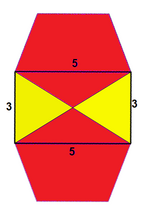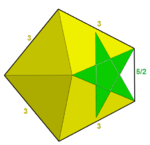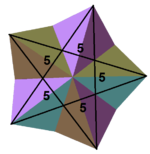Vertex configuration
Notation for a polyhedron's vertex figure From Wikipedia, the free encyclopedia
Notation for a polyhedron's vertex figure From Wikipedia, the free encyclopedia
In geometry, a vertex configuration[1][2][3][4] is a shorthand notation for representing the vertex figure[dubious – discuss] of a polyhedron or tiling as the sequence of faces around a vertex. For uniform polyhedra there is only one vertex type and therefore the vertex configuration fully defines the polyhedron. (Chiral polyhedra exist in mirror-image pairs with the same vertex configuration.)
 Icosidodecahedron |
 Vertex figure represented as 3.5.3.5 or (3.5)2 |
A vertex configuration is given as a sequence of numbers representing the number of sides of the faces going around the vertex. The notation "a.b.c" describes a vertex that has 3 faces around it, faces with a, b, and c sides.
For example, "3.5.3.5" indicates a vertex belonging to 4 faces, alternating triangles and pentagons. This vertex configuration defines the vertex-transitive icosidodecahedron. The notation is cyclic and therefore is equivalent with different starting points, so 3.5.3.5 is the same as 5.3.5.3. The order is important, so 3.3.5.5 is different from 3.5.3.5 (the first has two triangles followed by two pentagons). Repeated elements can be collected as exponents so this example is also represented as (3.5)2.
It has variously been called a vertex description,[5][6][7] vertex type,[8][9] vertex symbol,[10][11] vertex arrangement,[12] vertex pattern,[13] face-vector.[14] It is also called a Cundy and Rollett symbol for its usage for the Archimedean solids in their 1952 book Mathematical Models.[15][16][17]
A vertex configuration can also be represented as a polygonal vertex figure showing the faces around the vertex. This vertex figure has a 3-dimensional structure since the faces are not in the same plane for polyhedra, but for vertex-uniform polyhedra all the neighboring vertices are in the same plane and so this plane projection can be used to visually represent the vertex configuration.
{3,3} = 33 Defect 180° |
 {3,4} = 34 Defect 120° |
 {3,5} = 35 Defect 60° |
 {3,6} = 36 |
 {4,3} Defect 90° |
 {4,4} = 44 |
 {5,3} = 53 Defect 36° |
 {6,3} = 63 |
| A vertex needs at least 3 faces, and an angle defect. A 0° angle defect will fill the Euclidean plane with a regular tiling. By Descartes' theorem, the number of vertices is 720°/defect (4π radians/defect). | |||
Different notations are used, sometimes with a comma (,) and sometimes a period (.) separator. The period operator is useful because it looks like a product and an exponent notation can be used. For example, 3.5.3.5 is sometimes written as (3.5)2.
The notation can also be considered an expansive form of the simple Schläfli symbol for regular polyhedra. The Schläfli notation {p,q} means q p-gons around each vertex. So {p,q} can be written as p.p.p... (q times) or pq. For example, an icosahedron is {3,5} = 3.3.3.3.3 or 35.
This notation applies to polygonal tilings as well as polyhedra. A planar vertex configuration denotes a uniform tiling just like a nonplanar vertex configuration denotes a uniform polyhedron.
The notation is ambiguous for chiral forms. For example, the snub cube has clockwise and counterclockwise forms which are identical across mirror images. Both have a 3.3.3.3.4 vertex configuration.
The notation also applies for nonconvex regular faces, the star polygons. For example, a pentagram has the symbol {5/2}, meaning it has 5 sides going around the centre twice.
For example, there are 4 regular star polyhedra with regular polygon or star polygon vertex figures. The small stellated dodecahedron has the Schläfli symbol of {5/2,5} which expands to an explicit vertex configuration 5/2.5/2.5/2.5/2.5/2 or combined as (5/2)5. The great stellated dodecahedron, {5/2,3} has a triangular vertex figure and configuration (5/2.5/2.5/2) or (5/2)3. The great dodecahedron, {5,5/2} has a pentagrammic vertex figure, with vertex configuration is (5.5.5.5.5)/2 or (55)/2. A great icosahedron, {3,5/2} also has a pentagrammic vertex figure, with vertex configuration (3.3.3.3.3)/2 or (35)/2.
 |  |
 |
 |
 |
| {5/2,5} = (5/2)5 | {5/2,3} = (5/2)3 | 34.5/2 | 34.5/3 | (34.5/2)/2 |
|---|---|---|---|---|
 |  |
 |
 |
 |
| {5,5/2} = (55)/2 | {3,5/2} = (35)/2 | V.34.5/2 | V34.5/3 | V(34.5/2)/2 |
Faces on a vertex figure are considered to progress in one direction. Some uniform polyhedra have vertex figures with inversions where the faces progress retrograde. A vertex figure represents this in the star polygon notation of sides p/q such that p<2q, where p is the number of sides and q the number of turns around a circle. For example, "3/2" means a triangle that has vertices that go around twice, which is the same as backwards once. Similarly "5/3" is a backwards pentagram 5/2.
Semiregular polyhedra have vertex configurations with positive angle defect.
NOTE: The vertex figure can represent a regular or semiregular tiling on the plane if its defect is zero. It can represent a tiling of the hyperbolic plane if its defect is negative.
For uniform polyhedra, the angle defect can be used to compute the number of vertices. Descartes' theorem states that all the angle defects in a topological sphere must sum to 4π radians or 720 degrees.
Since uniform polyhedra have all identical vertices, this relation allows us to compute the number of vertices, which is 4π/defect or 720/defect.
Example: A truncated cube 3.8.8 has an angle defect of 30 degrees. Therefore, it has 720/30 = 24 vertices.
In particular it follows that {a,b} has 4 / (2 - b(1 - 2/a)) vertices.
Every enumerated vertex configuration potentially uniquely defines a semiregular polyhedron. However, not all configurations are possible.
Topological requirements limit existence. Specifically p.q.r implies that a p-gon is surrounded by alternating q-gons and r-gons, so either p is even or q equals r. Similarly q is even or p equals r, and r is even or p equals q. Therefore, potentially possible triples are 3.3.3, 3.4.4, 3.6.6, 3.8.8, 3.10.10, 3.12.12, 4.4.n (for any n>2), 4.6.6, 4.6.8, 4.6.10, 4.6.12, 4.8.8, 5.5.5, 5.6.6, 6.6.6. In fact, all these configurations with three faces meeting at each vertex turn out to exist.
The number in parentheses is the number of vertices, determined by the angle defect.

The uniform dual or Catalan solids, including the bipyramids and trapezohedra, are vertically-regular (face-transitive) and so they can be identified by a similar notation which is sometimes called face configuration.[3] Cundy and Rollett prefixed these dual symbols by a V. In contrast, Tilings and patterns uses square brackets around the symbol for isohedral tilings.
This notation represents a sequential count of the number of faces that exist at each vertex around a face.[18] For example, V3.4.3.4 or V(3.4)2 represents the rhombic dodecahedron which is face-transitive: every face is a rhombus, and alternating vertices of the rhombus contain 3 or 4 faces each.
Seamless Wikipedia browsing. On steroids.
Every time you click a link to Wikipedia, Wiktionary or Wikiquote in your browser's search results, it will show the modern Wikiwand interface.
Wikiwand extension is a five stars, simple, with minimum permission required to keep your browsing private, safe and transparent.